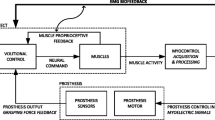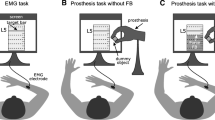Abstract
This study investigates the use of features extracted from intramuscular electromyography (EMG) for estimating grasping force in the ipsilateral and contralateral (mirrored) hand, during bilateral grasping tasks. This is relevant since force estimation using mirror tasks is a potentially useful pathway for the clinical training of unilateral amputees. Bilateral grasping force and intramuscular EMG (wire electrodes) of the right forearm were measured in 10 able-bodied subjects. The features extracted from the EMG signal were the root mean square, the global discharge rate, the standard sample entropy, and the constraint sample entropy (CSE). The association between the EMG features and force was modeled using a first-order polynomial model, a second-order exponential model, and an artificial neural network (ANN). The accuracies of estimation of ipsilateral and mirrored grasping force were not significantly different (e.g., R 2 = 0.89 ± 0.02 for ipsilateral and 0.88 ± 0.017 for mirrored, when using CSE and the ANN). It was concluded that it is possible to use just one channel of intramuscular EMG for force estimation. This result suggests that intramuscular EMG signals may be suitable for proportional myoelectric control and that training of the association between intramuscular EMG features and force can be performed using mirror tasks, which is a needed condition for applications in unilateral amputees.




Similar content being viewed by others
Abbreviations
- RMS:
-
Root mean square
- GDR:
-
Global discharge rate
- SSE:
-
Standard sample entropy
- CSE:
-
Constraint sample entropy
- ANN:
-
Artificial neural network
References
Baker, J. J., D. Yatsenko, J.F. Schorsch, G. A. DeMichele, P. R. Troyk, D. T. Hutchinson, R. F. Weir, G. Clark, and B. Greger. Decoding individuated finger flexions with implantable myoelectric sensors. Conf. Proc. IEEE Eng. Med. Biol. Soc. 2008:193–196, 2008.
Close, J. R., E. D. Nickel, and F. N. Todd. Motor-unit action potential counts, their significance in isometric and isotonic contractions. J. Bone Joint Surg. Am. 42:1207–1222, 1960.
De Luca, C., R. LeFever, M. McCue, and A. Xenakis. Behaviour of human motor units in different muscles during linearly varying contractions. J. Physiol. 329:113–128, 1982.
Duque, J., D. Masset, and J. Malchaire. Evaluation of handgrip force from EMG measurements. Appl. Ergon. 26:61–66, 1995.
Goldberger, A. L., L. A. N. Amaral, L. Glass, J. M. Hausdorff, P. Ch. Ivanov, R. G. Mark, J. E. Mietus, G. B. Moody, C. K. Peng, and H. E. Stanley. PhysioBank, PhysioToolkit, and PhysioNet: components of a new research resource for complex physiologic signals. Circulation 101(23):e215–e220, 2000.
Gurram, R., S. Rakheja, and G. J. Gouw. A study of hand grip pressure distribution and EMG of finger flexor muscles under dynamic loads. Ergonomics 38:684–699, 1995.
Herberts, P., R. Kadefors, and I. Petersen. Implantation of micro-circuits for myoelectric control of prosthetises. J. Bone Joint Surg. 50B:780–791, 1968.
Hoozemans, M. J., and J. H. van Dieën. Prediction of handgrip forces using surface EMG of forearm muscles. J. Electromyogr. Kinesiol. 15:358–366, 2005.
Inman, V. T., H. J. Ralston, J. B. Saunders, B. Feinstein, Jr., and E. W. Wright. Relation of human electromyogram to muscular tension. Electroencephalogr. Clin. Neurophysiol. 4:187–194, 1952.
Jiang, N., K. B. Englehart, and P. A. Parker. Extracting simultaneous and proportional neural control information for multiple degree of freedom prostheses from the surface electromyographic signal. IEEE Trans. Biomed. Eng. 56:1070–1080, 2009.
Kamavuako, E. N., D. Farina, K. Yoshida, and W. Jensen. Relationship between grasping force and features of single-channel intramuscular EMG signals. J. Neurosci. Methods. 85:143–150, 2009.
Keir, P. J., and J. P. Mogk. The development and validation of equations to predict grip force in the workplace: contributions of muscle activity and posture. Ergonomics 48:1243–1259, 2005.
Khandoker, A. H., H. F. Jelinek, and M. Palaniswami. Identifying diabetic patients with cardiac autonomic neuropathy by heart rate complexity analysis. BioMed. Eng. Online 8:3, 2009.
Merrill, D. R., J. Lockhart, P. R. Troyk, R. F. Weir, and D. L. Hankin. Development of an implantable myoelectric sensor for advanced prosthesis control. Artif Organs. 35:249–252, 2011.
Nielsen, J. L. G., S. Holmgaard, N. Jiang, K. Englehart, D. Farina, and P. Parker. Simultaneous and proportional force estimation for multifunction myoelectric prostheses using mirrored bilateral training. IEEE Trans. Biomed. Eng. 58:681–688, 2011.
Onishi, H., R. Yagi, K. Akasaka, K. Momose, K. Ihashi, and Y. Handa. Relationship between EMG signals and force in human vastus lateralis muscle using multiple bipolar wire electrodes. J. Electromyogr. Kinesiol. 10:59–67, 2000.
Richman, J. S., and J. R. Moorman. Physiological time-series analysis using approximate entropy and sample entropy. Am. J Physiol 278:H2039–H2049, 2000.
Schultz, A. E., and T. A. Kuiken. Neural interfaces for control of upper limb prostheses: the state of the art and future possibilities. PM R. 3:55–67, 2011.
Weir, R., P. Troyk, G. Demichele, and D. Kerns. Technical details of the implantable myoelectric sensor (IMES) system for multifunction prosthesis control. Conf. Proc. IEEE Eng. Med. Biol. Soc. 7:7337–7340, 2005.
Acknowledgments
This study was supported by a grant from the Danish Agency for Science, Technology and Innovation (Council for Independent Research|Technology and Production Sciences, Grant number 10-080813) (ENK) and by the ERC Advanced Research Grant DEMOVE (“Decoding the Neural Code of Human Movements for a New Generation of Man–machine Interfaces”; no.: 267888) (DF).
Author information
Authors and Affiliations
Corresponding author
Additional information
Associate Editor Catherine Disselhorst-Klug oversaw the review of this article.
Rights and permissions
About this article
Cite this article
Kamavuako, E.N., Farina, D., Yoshida, K. et al. Estimation of Grasping Force from Features of Intramuscular EMG Signals with Mirrored Bilateral Training. Ann Biomed Eng 40, 648–656 (2012). https://doi.org/10.1007/s10439-011-0438-7
Received:
Accepted:
Published:
Issue Date:
DOI: https://doi.org/10.1007/s10439-011-0438-7




